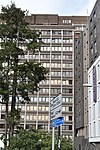Sidcup railway station
1866 establishments in EnglandBuildings and structures in SidcupDfT Category C2 stationsFormer South Eastern Railway (UK) stationsLondon stations without latest usage statistics 1415 ... and 6 more
London stations without latest usage statistics 1516Rail transport stations in London fare zone 5Railway stations in Great Britain opened in 1866Railway stations in the London Borough of BexleyRailway stations served by SoutheasternUse British English from August 2012

Sidcup railway station serves Sidcup, south-east London, within the London Borough of Bexley. It is 11 miles 73 chains (19.2 km) down the line from London Charing Cross. It is in Travelcard Zone 5, and the station is managed by Southeastern.
Excerpt from the Wikipedia article Sidcup railway station (License: CC BY-SA 3.0, Authors, Images).Sidcup railway station
Jubilee Way, London Longlands (London Borough of Bexley)
Geographical coordinates (GPS) Address Nearby Places Show on map
Geographical coordinates (GPS)
| Latitude | Longitude |
|---|---|
| N 51.4338 ° | E 0.104 ° |
Address
Sidcup
Jubilee Way
DA14 4BL London, Longlands (London Borough of Bexley)
England, United Kingdom
Open on Google Maps







